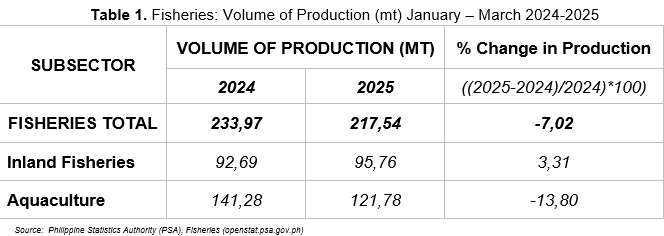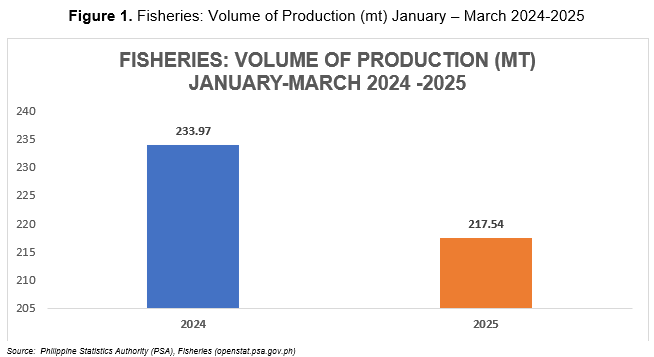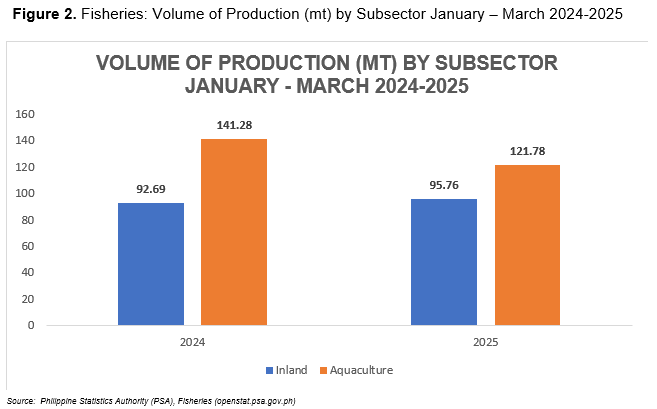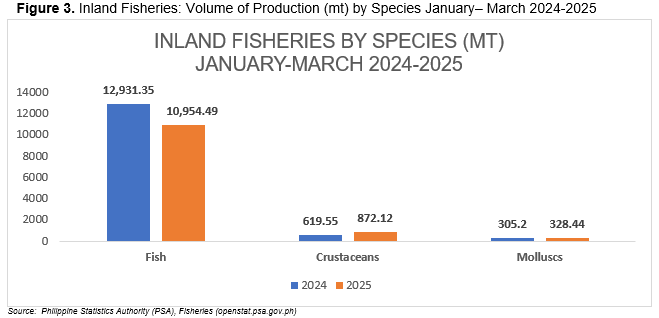
The fishery sector in Quirino Province remains vital to food security, livelihoods, and the local economy. In 2025, Quirino’s fisheries sector is composed of two subsectors which are the Inland fisheries and aquaculture. Fisheries production in Quirino declined by 7.02 percent, dropping from 233.97 metric tons in 2024 to 217.54 metric tons in 2025. The decrease was primarily due to reduced aquaculture harvests, as fewer ponds were stocked last quarter following with typhoon-related flooding and high input costs (Table 1, Figure 1).


Inland fisheries production for the 1st quarter 2025 increased to 95.76 metric tons, up from 92.69 metric tons in 2024 (Table 1, Figure 2). This growth was attributed to an abundant fish catch in communal bodies of water (CBWs), supported by normal water levels and increased fishing efforts driven by economic needs.
On the other hand, aquaculture production declined to 121.78 metric tons from 141.28 metric tons the previous year (Table 1, Figure 2). The decrease was mainly due to a reduction in the area harvested, as fewer ponds were stocked in the previous quarter. This was a result of typhoon-related flooding and high input costs affecting fish farming operations.

Inland Fisheries
Inland fisheries in Quirino for the 1st quarter 2025 showed varied performance across different species groups. Fish species production decreased from 12,931.35 metric tons in 2024 to 10,954.49 metric tons in 2025. Meanwhile, crustacean species increased from 619.55 metric tons to 872.12 metric tons, and molluscs production rose from 305.20 metric tons to 328.44 metric tons (Figure 3). The increase in crustaceans and molluscs were attributed to the greater appearance and catch of these species, supported by normal water levels in fishing grounds during the quarter.

Aquaculture
Aquaculture production in Quirino for the first quarter of 2025 showed a decline across different farm types. Freshwater fishpond production decreased from 139.09 metric tons in 2024 to 119.61 metric tons in 2025 (Figure 4) due to less area harvested, as fewer ponds were stocked in the previous quarter following typhoon-related flooding and high input costs.
Similarly, production from small farm reservoirs declined slightly from 2.19 metric tons in 2024 to 2.17 metric tons in 2025 (Figure 4), attributed to reduced area harvested as a result of lower reliance on commercial feeds due to increased prices of inputs.
Definition of Terms
Aquaculture is a fishery operation involving all forms of raising and culturing of fish and other fishery species in fresh, brackish and marine water areas. (RA No. 8550)
Aquaculture production refers to the quantity produced and actually harvested from the aquafarm during the reference period. Species harvested should be in marketable/matured size and in fresh form such as mussel and oyster in shell. It includes those harvested but damaged, stolen, given away, consumed, given as harvester’s share, reserved, etc.
Aquafarm type
Fishpond refers to a land-based type of aquafarm; a body of water (artificial or natural) where fish and other aquatic products are cultured, raised or cultivated under controlled conditions.
Small Farm Reservoir (small water body) includes reservoirs and lakes with an area of less than 10 m2, small ponds, canals, irrigation canals, swamps and small, seasonal, inland floodplains. They may be permanent or temporary and can be separated into natural waters or constructed ones.
Inland fisheries is the catching of fish, crustaceans, molluscs and other aquatic animals and plants in inland water like lakes, rivers, dams, marshes, etc. using simple gears and fishing boats, some of which are non-motorized with a capacity of three gross tons or less; or fishing not requiring the use of fishing boats.
Inland fisheries production is the quantity of catch, presented in metric tons, including those for home consumption, including those intended for home consumption, given away, paid to crew, and/or rejected due to poor quality of
the species.
ENGR. CHERRY GRACE D. AGUSTIN
Chief Statistical Specialist
msl/rdc
